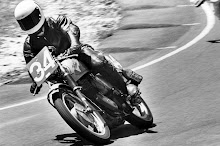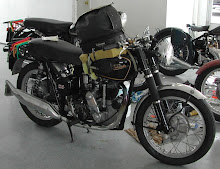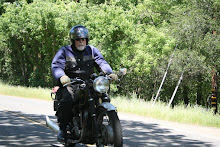The photographs were scanned from the newspaper print and so their quality suffers as a result.
Acknowledgement is made to Mortons Motorcycle Media Ltd.
Because of the mention of newsprint photo quality , these illustrated are better not enlarged.
Hold a finger in the middle of an ordinary-looking loop of copper tube and nothing happens; yet place a piece of metal within the same loop and in a few seconds it is glowing cherry red. Magic? It may seem so- and the mysterious cabinet, with its panel of knobs, switches and dials, from which the copper loop projects could well be part of the mumbo-jumbo of a stage illusionist.
 But in fact this is a radio-frequency induction heating, a process which is coming more and more into prominence in engineering. It has particular applications in motor-cycle manufacture and Velocettes’, to quote a specific factory, began in a small way by using the system for hardening the tips of clutch-plate discs; now induction heating is used in frame brazing, for fixing hardened pads to cam followers and in many other ways.
But in fact this is a radio-frequency induction heating, a process which is coming more and more into prominence in engineering. It has particular applications in motor-cycle manufacture and Velocettes’, to quote a specific factory, began in a small way by using the system for hardening the tips of clutch-plate discs; now induction heating is used in frame brazing, for fixing hardened pads to cam followers and in many other ways.The principle is not unlike that of an ignition coil. The metal part to be heated is placed within a coil of copper tubing (tubing, for a reason which will be explained shortly) and an alternating current is passed through the coil winding. As with the ignition coil, a secondary current is thereby induced with, in this instance, the component to be treated replacing the usual secondary windings. The electric impulses disturb the molecular structure of the metal and thus heat is produced.
 By heating quickly enough only the surface layer is affected-ideal when hardening or tempering is to be done. For other processes the whole component must be heated through, and so the rate of heating is slowed down. Control is obtained by using coils which may be tightly looped for speed heating) or loose-coiled (for through-heating).
By heating quickly enough only the surface layer is affected-ideal when hardening or tempering is to be done. For other processes the whole component must be heated through, and so the rate of heating is slowed down. Control is obtained by using coils which may be tightly looped for speed heating) or loose-coiled (for through-heating).There must be no direct contact between coil and compartment, or a short would occur; and so that the coil is not affected by heat reflected from the continuously through the tubing from which the coil is constructed. Further, to obviate arcing, the copper is first discovered with spun-glass then given a coating of shellac.
So far, so good. But town mains supply is usually at either, 50 or 60 cyles per second, and at so slow a rate of reversal the heating effect is negligible. The smaller the part to be heated, the higher the frequency is required, but for most of the purposes a frequency of about 400
 kilocycles per second is used. And that is where the magic cabinet comes in for it is, in a way, a
kilocycles per second is used. And that is where the magic cabinet comes in for it is, in a way, a  radio transmitter, stepping up the normal factory supply to the high frequency necessary by means of a transformer, with associated mercury-vapour rectifiers and oscillator valves.
radio transmitter, stepping up the normal factory supply to the high frequency necessary by means of a transformer, with associated mercury-vapour rectifiers and oscillator valves.First the transformer takes the ordinary input (at, say, 220 volts) and delivers it at 6,000 volts to the rectifiers; they, in turn, convert it from A.C. to D.C. and pass it to the oscillator valves, from which it emerges as A.C. current once more, but this time at 400,000 cycles per second. Even then an output transformer is brought into the circuit, so that voltage and current may be varied according to the job at hand.
As to the coils themselves, the shape can be varied in many ways- long coils, short loops, square coils, flat coils; it all depends on the shape of the component to be heated, and the substitution of one more coil for another when a change in the production run is made is a simple matter. The use of the apparatus is almost limitless. To take the Velocette clutch plate as an example, by the earlier production method the whole plate would first have had to be copper plated, to prevent carbon penetration, and then the copper would have been scraped away from those parts where penetration was, in fact, wanted. Carburizing would follow, then the plate would be quenched- and distortion could quite easily result. Now, just the tips of the plate are passed, one at a time, through an induction coil; the heat is applied only where necessary and distortion cannot arise.
 Again, a coil can be arranged for internal heating- as in the case of a light alloy cylinder barrel which should be heated before the iron liner is fitted into place. The whole job can be done in one and a half minutes whereas by the conventional method of placing a stack of barrels in an electric furnace only six could be treated in half an hour.
Again, a coil can be arranged for internal heating- as in the case of a light alloy cylinder barrel which should be heated before the iron liner is fitted into place. The whole job can be done in one and a half minutes whereas by the conventional method of placing a stack of barrels in an electric furnace only six could be treated in half an hour.Another example of time-saving? Certainly; at one time a Velocette oil-pump spindle, complete with the gear wheel it carries, had to be turned from the solid. Now the spindles is cut from the pre-ground stock, the pinion is cut in the normal manner and is bored so that there is 0.0005in clearance between shaft and bore, and the two components are silver soldered together in the induction heater. And while one component is heating the operator can prepare the next.
But perhaps the most spectacular piece of magic is that which brazes the trunnion lug (brake anchor lug) to one arm of the pivoted rear fork. The operator picks up the length of tube, paints it with a liquid flux at the appropriate place, then slips the lug to be brazed over the tube and into its appointed station. Next a ring of wire- the hard sliver-solder-is wrapped round the tube at the junction of the tube and lug.
The tube is then placed vertically, silver-solder ring uppermost, in a fixture so that the lug is within a heating coil.
Within seconds the lug glows red then- phhtt! In a flash the solder ring has disappeared , as the molten metal penetrates between lug and tube to form a secure bond.
Compare that with the traditional frame-building methods of gas torch, fire-brick hearth and consequent distortion- which is rectified by brutal-seeming leverage with a crowbar until the frame matches the trueing jig! And when it comes to brazing the steering-head lug in place, other advantages make themselves known, for now the lug can be fully machined before assembly. Formerly, because of consequent distortion, machining had to be carried out after brazing. Nor is there need for shot-blasting to remove brazing deposits as is the case with time-honoured methods.
It's interesting to see the huge size of the "electronics" in 1960..today one would imagine it was about the size of a home computer unit.









1 comment:
Nice blog spot your given a good information about copper tube and it is valuable information for us.
Post a Comment